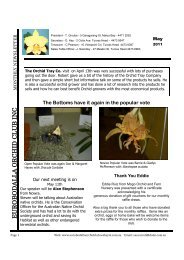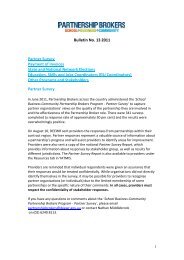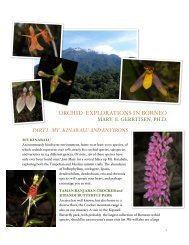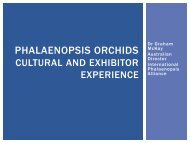Orchid Growing Substrates
Orchid Growing Substrates
Orchid Growing Substrates
Create successful ePaper yourself
Turn your PDF publications into a flip-book with our unique Google optimized e-Paper software.
<strong>Orchid</strong> <strong>Growing</strong> <strong>Substrates</strong><br />
Introduction<br />
There is a wide range of potting materials that can be used. In the old times, composted Oak leaf was used,<br />
so were the osmunda fern fiber and sphagnum. Worldwide a wide range of potting mixes have been and are<br />
used, from dried fern leaves in Indonesia to shredder tyre, through Rockwool, glass beads, bark, sphagnum,<br />
peat, loam and the list goes on…<br />
Whilst there is at least one grower in the world having ‘success’ with each and every of these components,<br />
there must be a scientific basis on the use, and the eventual blending of the components. Some very<br />
common products in one region are an absolute rarity in some others. Tree fern fiber is exceedingly common<br />
in Vietnam and China, but exceedingly rare in England, where it needs to be imported. On the opposite,<br />
Rockwool produced in Europe and readily available is very rare in Indonesia.<br />
To most growers, hobbyists and professionals alike, one potting mix material is the same no matter the<br />
source. Sphagnum from Europe, the USA, New Zealand, Chile and China make up for only one type in most<br />
grower’s mind. Red lava rock, bark, peat represent in most people’s minds ‘one’ compound, where each is not<br />
a component, but a category comprising vastly different products.<br />
Recently, in Europe, the mindset has changed. After several massive storms over the last few decades, a lot of<br />
pine tree forests were severely damaged. The growers, who ordered ‘pine bark’ for ages, suddenly got pine<br />
bark, but it did not behave the same way as it did before. The trade called this type ‘storm bark’, because it<br />
was from weakened, sometimes already dead trees. A few years later, ‘juvenile’ bark came on the market,<br />
from younger tree plantations. The growers were buying one bark, one size, but at the end realized they got 3<br />
vastly different materials, with vastly different behaviors. It was the awakening, which was tampered only by<br />
the sellers, explaining that, in fact, they were the ‘same product’, and made hidden adjustments to try to keep<br />
their customers. In America, the bark suffered the same fate too, where one of the best bark producers<br />
decided to stop its production for orchids, and most other companies decided to reserve some batches of<br />
their mulching bark for the orchid growers, instead of doing a specific product as they did before. It has been<br />
the time of the coconut chips too, which were supposed to be wonderful, and would replace within ‘a year or<br />
two’ according to their promoters, the bark from all around the world. They were economic, ecologic, a true<br />
‘green product’, and working wonderfully… not. It did not happen, mostly because in a lot of cases, the<br />
suppliers, the traders, the sellers, and the growers have different objectives and thinking, and different<br />
results. A supplier is successful if he sells a container of coconut chips, but a grower is successful if his plants<br />
grow well. So the supplier can deem a good success, but the grower, on the same container, can kill his plants,<br />
like it happened countless times, and be on the verge of bankruptcy.<br />
There have been a lot of companies, catering to either the pot plant trade, or the hobby trade, and even some<br />
really famous orchid growers, which collapsed partially or fully because of the potting mix. In fact, all of this is<br />
easy to explain, and that’s what we are going to do here.<br />
Xavier Garreau de Loubresse<br />
2
















